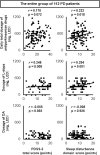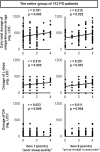Antiparkinsonian drugs as potent contributors to nocturnal sleep in patients with Parkinson's disease
- PMID: 34320022
- PMCID: PMC8318227
- DOI: 10.1371/journal.pone.0255274
Antiparkinsonian drugs as potent contributors to nocturnal sleep in patients with Parkinson's disease
Abstract
Objective: To clarify whether antiparkinsonian drugs contribute to nocturnal sleep disturbances in patients with Parkinson's disease (PD).
Background: Although the major antiparkinsonian drugs L-dopa and dopamine agonists (DAs) have been found to affect sleep, little is known about the effects of specific drugs on sleep in PD patients.
Methods: The study participants consisted of 112 PD patients (median age 72.5 years [inter-quartile range: IQR 65-79]; mean disease duration 8.44 years [standard deviation: 7.33]; median Hoehn and Yahr stage 3 [IQR 2-3.75]) taking one of three types of non-ergot extended-release DAs (rotigotine 32; pramipexole 44; ropinirole 36) with or without L-dopa (median daily total dosage of antiparkinsonian drugs 525.5 mg [IQR 376.25-658] levodopa equivalent dose [LED]). Participants were assessed using the PD Sleep Scale-2 (PDSS-2).
Results: For the whole PD patient cohort, the PDSS-2 sleep disturbance domain score and the scores for item 1 assessing sleep quality and item 8 assessing nocturia were positively correlated with daily total dosage of antiparkinsonian drugs and dosage of L-dopa, but not with the dosage of DAs. Sub-analysis according to DA treatment revealed that DA dosage was not correlated with item 1 or 8 score in any of the subgroups. The LED ratio of rotigotine to the total dosage of antiparkinsonian drugs was inversely correlated with the item 1 score.
Conclusions: These data suggest that antiparkinsonian drugs, in particular L-dopa, adversely affect nocturnal sleep in PD patients, especially in terms of sleep quality and nocturia. Thus, adjusting both the total dosage of antiparkinsonian drugs and the dose-ratio of L-dopa might be key actions for alleviating poor sleep quality in patients with PD. Among DAs, we found a clear positive correlation between the dose-ratio of rotigotine and sleep quality. Thus, partial L-dopa replacement with rotigotine could improve sleep quality in patients with PD.
Conflict of interest statement
The authors declare that no competing interests exist.
Figures



References
Publication types
MeSH terms
Substances
LinkOut - more resources
Full Text Sources
Medical

